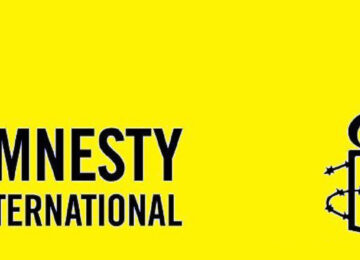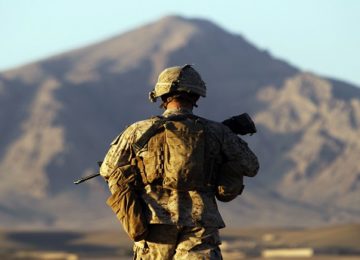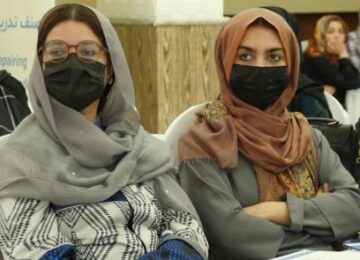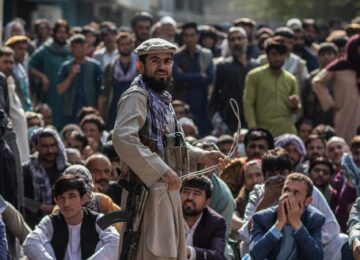Afghan Shia Muslims are feeling increasingly beleaguered after two massacres targeting their community this month. Both were claimed by the Afghan ‘franchise’ of Daesh, the Islamic State in Khorasan Province (ISKP). On 3 August, gunmen killed at least 38 men and boys during Friday prayers at a village mosque in the outskirts of Gardez city. Three families lost all their men, from young boys to grandfathers. This week, on 15 August, a suicide bomber walked into an education centre in the Hazara-majority Dasht-e Barchi neighbourhood of Kabul. At least 40 people were killed, most of them teenage students, girls and boys, who had been studying for the university entrance exam. In the midst of this onslaught, AAN felt the need to pay tribute to at least some of the victims, in an attempt to make sure such deaths do not become the ‘routine’ of this conflict. Here, AAN’s Fabrizio Foschini looks at what happened when the small community of Shia Sadat (descendants of the Prophet) in Paktia province came under attack.
Sectarian attacks are on the rise in Afghanistan, with Shia Muslim mosques, gatherings and neighbourhoods being targeted. This month has been hard, with first the attack on the Khwajah Hassan mosque in Paktia province and then a lone suicide bomber attacking the Mu’ud education centre in the capital. It left at least 48 dead and 67 wounded, mainly teenagers, dead and injured. “The lecture hall had been so packed,” one journalist wrote, “and the explosion so powerful that nearly half the 230 students were among the casualties.” Many were from the provinces, sent by their families to spend a last year studying in the capital in the hope of passing the kankur university entrance examination and getting into higher education. Some, with no family in Kabul, were buried in a mass grave by their school fellows and volunteers. Unusually, some of the coffins of the girls were carried by women.
Such sectarian attacks are perpetrated by a sliver of Afghan society – ISKP usually claims them – and are always widely condemned. This was the case also in the wake of the attack on the Khwajah Hassan mosque in Gardez where the bereaved were actively supported by their Sunni neighbours. Masses of Sunnis attended the funerals of those killed in the attack and later posted themselves as human shields in Shia mosques and shrines, challenging sectarian haters to kill them as well. AAN has spoken to members of the community, to bring you this account of the attack and of the small community which has lost so many members.
The attack at the Friday prayer
It was around 13.30 on a Friday afternoon. A significant portion of the residents of Khwajah Hassan village had come to the mosque to listen to the preacher deliver the khutba and perform the congregational prayer when two burqa-clad figures approached the precinct. (1) The tattered state of their clothes and their attitude – reaching their arms out from under their cloaks as if to ask for alms – identified them as beggars, who often count on the charity of believers gathered for Friday prayers. The guards at the gates told them to wait a few minutes; as soon as the people completed their prayers, they said, and came out of the mosque, there would certainly be something for them. The two beggars turned as if to comply, but instead drew from under their burqas hidden guns, reportedly with silencers, shot the guards dead, and rushed towards the mosque.
This, according to the few who witnessed it and lived to tell the tale, is how the attack on the mosque of the Imam-e Zaman in Khwajah Hassan village on the outskirts of Gardez on 3 August 2018 started. What happened subsequently was carnage.
The mosque was built only two years ago, with contributions from the whole local Shia community. It replaced an older, smaller one and could host up to 2,000 people. That day between 150 and 200 residents were present – men and boys only, as women and girls, despite having a separate floor at their disposal, did not usually attend the congregational prayer. As is customary, community leaders and elderly men found their places in the first rows, while the youth and children sat at the back. They were the first to be met when the terrorists entered the building. The two gunmen first threw hand grenades into the crowd, then opened fire on those closer to them with the Kalashnikovs they had concealed under their clothes. A majority of the wounds, it was later reported, were from bullets and grenade shrapnel, showing this stage of the attack to have been the deadliest. Then, one after the other, the attackers activated the explosive vests they were wearing, killing and injuring even more of the people around them (see also media reporting here and here).
Survivors and local residents who rushed to the incident started to move the wounded to hospital. Later, those with only minor injuries were taken to the centre of Gardez city where they were paraded in an impromptu protest in front of the provincial government buildings. The people of Khwajah Hassan were not only bewildered by the massacre, but also by the delay on the part of the authorities in sending ambulances and security forces after the attack. Some residents told AAN that this took more than an hour, even though Khwajah Hassan is a suburb of Gardez located in Police District 2, and barely two kilometres from the city centre. Tension was so great that when the police finally arrived at the scene of the attack, armed local residents prevented them from entering the mosque, asking them what they had come for, now that everybody was dead (see also this reporting from Pajhwok).
Meanwhile, local clinics could not cope with the numbers of injured and the dire state some were in. Finally, at around 19:00 in the evening, 19 of the most seriously wounded were evacuated to different Kabul hospitals by military helicopter. Some would nonetheless die from their wounds in the following days.
The victims
This attack killed 33 people and injured dozens more. It devastated a whole community. The Shia Muslims of Gardez are Sadat – descendants of the Prophet. Living far from other Shias, they have developed a deeply intertwined community. The 3 August attack cut through these ties, leaving every family mourning the death of near or distant relations. Three families lost all the men of their household, from the young boys to the grandfathers.
Five children aged between 7 and 15 were killed and a further seven wounded seriously. An additional eight young people under the age of 25 are dead and many more injured. The total number of injured people is, as usual, a fluid figure, as many with only superficial cuts or burns were not hospitalised or counted and some may still die of their injuries. The estimate, however, ranges between 70 and 90, with around a dozen still in critical condition.
Among the dead were some of the community’s elders. The most well-known and respected was probably Dr Ali Shah Musawi, who had the singular distinction of being the only Shia prisoner incarcerated by the United States in Guantanamo Bay. During the 1980s, Dr Musawi had been a commander with the mujahedin party Harakat-e Inqilab-e Islami, in the wing led by Mawlawi Mansur. (2) While the Taleban were in power, Dr Musawi resided in Iran and did not take part in politics or fighting. Upon his return in 2004, he was immediately arrested by the Americans and later sent to Guantanamo where he spent two years as a prisoner. He was subject not only to detention without trial, but also, as the sole Shia prisoner among many radical Salafi Sunnis, to sectarian hatred by some of his fellow prisoners. His time in the detention camp was rough, even by Guantanamo standards. (3)
After being released, Dr Musawi went to Iran for a while to see his family, but ultimately settled back in Gardez, where he opened a primary school. More recently, in 2014, he had taken up the position of director of the local Department for the Prevention of Natural Disasters, where according to everybody AAN talked to, he was doing a good job. His nephew on his sister’s side, Sayyed Sajjad, aged 24, an engineer who had graduated from the Polytechnic of Kabul, was also killed.
The following is a list of those who were killed and have been honoured on the martyrdom posters and banners that have appeared across Gardez and in Kabul. Some of those who later died of their injuries do not appear here. We think, for example, that there was a second Sayyed Sajjad was killed in the attack.
- Sayyed Ahmad Khair Andish, imam of Khawja Hassan mosque, aged 40
- Dr Sayyed Muhammad Ali Shah Musawi, provincial head of the Disaster Management Office and former mujahedin commander
- Sayyed Muhammad Musawi, imam of Sadat mosque, originally from Jaghori,
- Sayyed Asadullah Rezai, taxi driver on the route between between Kabul and Gardez
- Sayyed Humayun, car mechanic in Gardez, aged 35
- Sayyed Murtaza, employee of Paktia University (brother of Sayyed Muhammad Reza, number 14, who was also killed)
- Sayyed Mahram, aged 22, businessman
- Sayyed Gul Ahmad, shopkeeper
- Sayyed Asadullah, aged 33, a qari (reader) of the Quran,
- Eng Sayyed Saifullah, student at Paktia University
- Eng Sayyed Sajjad, aged 24, head of Paktia Airport and nephew of Dr Musawi
- Sayyed Najibullah, son of Sayyid Amir Gul, lecturer at the Paktia University, aged 34
- Sayyed Muhammad Reza, shopkeeper (brother of Sayyed Murtaza, number 7)
- Sayyed Jan Ali, guard at the mosque
- Sayyed Agha Zia, son of Sayyid Nur Agha, aged 28, guard at the mosque
- Sayyed Mahram, aged 60, car mechanic
- Sayyed Zalmai, labourer
- Sayyed Ali Shah Musawi, tribal elder
- Sayyed Murtaza, a student at Paktia University
- Sayyed Rukai, a 17-year old school student
- Sayyed Kabir, a 16 or 17-year old school student
- Sayyed Muhammad Hussain, policemanoriginally from Bamyan
- Sayyed Muhammad, shopkeeper
- Sayyed Muhammad Agha, guard at the mosque
- Sayyed Nematullah, shopkeeper
The following victims were all children, still at school:
- Sayyed Nasrullah
- Sayyed Hujjat Musawi
- Sayyed Ali Asghar, aged 9
- Sayyed Hussain Shah
- Sayyed Murtaza
- Sayyed Ali Ahmad
- Sayyed Khalil
- Sayyed Wahidullah
The Sadat of Gardez, a tiny Shia island in Loya Paktia
The location of the attack – Paktia province, which had thus far been spared sectarian violence – and the fact that it devastated a small and somewhat isolated Shia community lent it a particular vicious and destructive character.
Khwajah Hassan is a relatively big and prosperous village. Located at the northeastern edge of the town of Gardez, it sits right by the highway leading towards Logar and Kabul. With maybe a thousand families residing in and around it, Khwajah Hassan is reportedly the biggest village in Paktia to be inhabited by speakers of Dari as a mother tongue – although most of the Sadat are fully bilingual, speaking Pashto as well. Despite being at the core of the Pashtun heartland, with inhabitants renowned for vigorously following tribal customs and Pashtunwali, Paktia also features a consistent minority of people who speak Dari as their first language. They are not newcomers to the area, but rather the remnants of ancient populations that once inhabited many parts of what is today southeastern Afghanistan (such as the Barakis of Logar and the Farmulis of Paktika). Once called Farsiwan, they nowadays mostly fall into the macro-ethnic category of Tajik, except for the Shias among them (as the Tajik identity has come to implicitly assume a Sunni creed). Moreover, these Shia communities often trace their ancestry to the family of the Prophet Muhammad, forming a separate group called Sadat (singular Sayyed).
The Sadat’s claim to a distinguished ancestry usually confers on them a certain amount of religious charisma. Throughout history they have often provided religious leadership for other Shias and engaged in learned professions and education. The Sadat from Khwajah Hassan claim to have arrived from Sabzevar near Nishapur (nowadays in eastern Iran) shortly after the Islamic conquest of the Gardez area and to have lived there ever since, developing a prosperous and well-respected community, despite their distance from other Shias.
It seems the Sadat of Khwajah Hassan have had no conflict with their Sunni neighbours, be they fellow Dari-speakers (Tajiks) or Pashtuns. On the contrary, residents of the village interviewed by AAN pointed to instances of cooperation and unity between them and the Sunnis, from their shared participation in the jihad against the Soviets and the communist government to their united defence when Pacha Khan Zadran attacked Gardez in 2002.
After the attack on the mosque, masses of Gardez’s Sunnis attended the mourning ceremonies for the dead, provided armed security during the burials and later posed as human shields in Shia mosques and shrines, challenging sectarian haters to attack them as well.
The likely perpetrators
The residents of Khwajah Hassan seemed taken completely by surprise. In the past few weeks, the local NDS headquarters had issued threat warnings that attacks were to be expected, but the warning had not specifically referred to Khwajah Hassan and had also been issued to Sunni mosques along the highway to Ghazni. Security at the mosque was low: only a couple of armed guards had been stationed there, as had always been the case for the past few years. They were local youths who received a salary through the Ministry of Interior.
The choice of the target and the level of wanton violence against unarmed civilians worshipping in a mosque, indicates sectarian hatred as the motivation. However, the Khwajah Hassan attack is an outlier in terms of attacks on Shias because of its location. The Sadat of Gardez had never previously been attacked. Militants based in Paktia province had, thus far, so far avoided targeting whole communities. The province, like neighbouring Khost, features an active insurgency, but it remains somewhat curtailed by strong tribal affiliations and cohesive local communities. The sworn hostility of even a minor community can be a logistical nightmare for insurgents, as they have to rely on mountain routes or secrecy for the security of their movements and the success of their operations. This discourages acts that would antagonise whole communities.
Also, despite the Taleban’s not always clean record in the past (such as during their conquest of Mazar-e Sharif in the 1990s), sectarian violence is something they now publicly and emphatically condemned and distance themselves from. (4) Indeed, within hours after the attack, community leaders of Khwajah Hassan started receiving phone calls from Taleban front commanders in Janikhel, Zurmat and even Paktika province, denying any involvement in the attack, expressing their condolence for the victims and extending offers of assistance.
The actor that, since its appearance on the stage of the Afghan conflict in 2014 (see AAN analysis here and here), has proved more than willing to carry out such horrific sectarian attacks is Daesh/ISKP (see this AAN analysis). A string of attacks on Shia religious sites suggests that the group considers violent sectarian attacks an important part of their strategy – to gain resonance and renown at the national and international level, and to try to attract new recruits and funds (see this AAN analysis). The recent increase in such attacks may also be a response to the crisis the movement finds itself in, now that combined Taleban and government/US pressure has virtually eliminated Daesh from much of the territory it had controlled in Afghanistan in Nangrahar and Jawzjan (see AAN analysis here).
ISKP indeed claimed ownership of the attack, but only a full day after it happened, in the late afternoon of Saturday. On previous occasions, the group has usually been very keen to declare ownership and made claims within hours of an incident.
From the point of view of capability, Daesh, is also not the best-positioned to carry out an attack like this. Khwajah Hassan’s mosque may have been a soft target, but Daesh has never so far operated anywhere close to Gardez, and even a simple attack would have required extensive reconnaissance and knowledge of the area. A lot depends on the possibility that Daesh recruited militants in Gardez, because to bring in men and weapons from other provinces, at a time when the government controls the highway and the Taleban all the other routes, would have been very difficult.
Inhabitants of Khwajah Hassan – both Sunni and Shia – are adamant that the attack bears the signature of the Haqqani network. They believe this is the only group that could have carried it out with ease. This may well hold true in terms of operational capacity, but when it comes to motivation, things are less clear. A resident interviewed by AAN provided examples of how the Haqqanis have shown hostility against Shias in the past. During the jihad years and shortly after, the group’s fighters would harass Shia and object to their celebration of the festival of Ashura (the Sadat would then seek the mediation of Mawlawi Mansur, as many of them had fought in the ranks of his faction of Harakat-e Inqilab-e Islami). On another occasion, Jalaluddin Haqqani had insulted the local Shias in a public speech after the Taleban had come to power. (5) This alone, however, does not provide a clear reason for the current Haqqanis to perpetrate such a savage attack now.
The perpetrators of the attack, if they were trying to light the fire of sectarian hatred, causing a breach between the Sadat and their fellow Paktiawals, will be disappointed. Support for the grieving community has been strong. In the words of a political analysts hailing from Paktia: “The only fortunate thing in all this is that Paktiawals joined together for the commemoration of the dead of Khwajah Hassan. We stood collectively in abhorrence of this unprecedented attack.”
Edited by Martine van Bijlert and Kate Clark
(1) Not all Shia communities across the world maintain the need for the faithful to join the khutba, a sermon on religious, social and even political topics given before the Friday prayer, although this is usually the case among Afghan Shia communities.
(2) Harakat-e Inqilab-e Islami-ye Afghanistan was one of the major Sunni mujahedin parties that made up the ‘Peshawar Seven’. In 1982, Mawlawi Nasrullah Mansur, from Paktia’s Zurmat district, split from the main party, led by Mawlawi Muhammad Nabi Muhammadi, to form his own faction. This party, led by Nasrullah’s brother, Abdul Latif Mansur, would come to play a central role during the Taleban Emirate and in the insurgency after 2001. It is now known as the Mansur Network (for a background of the party and its resumed activities see here). That Dr Musawi and many Sadat joined what was basically a faction of traditional Sunni mullahs instead of seeking affiliation with one of the Shia mujahedin parties bears testimony to the high degree of integration the Sadat have enjoyed in Paktia society.
(3) Dr Musawi had come back to his home town in 2004 along with four friends and relatives (who were also returning home from Iran). The very night of their arrival, US soldiers broke into the house where they were staying, seized them and carried them to Bagram. His four companions were later released, but Dr Musawi was sent to Guantanamo where he spent two years. In his memoir Haqaiq-e nagofta-e Guantanamo (“Untold Facts about Guantanamo”), published after his release in 2006, he relates the problems he faced there, including performing prayers, given the sectarian intolerance of some of the more radical prisoners towards Shias.
(4) For a look at the historical record and context, see three dispatches AAN wrote in the wake of an attack on Ashura mourners in Kabul in December 2001 here, here and here)
(5) When making an introductory speech for the newly appointed governor in Gardez, in the presence of all the community elders of the province, Jalaluddin Haqqani reportedly praised the people of Paktia, comparing the province to a basin filled with pure, clean water only defiled by a few noxious vermin. At that point he paused and addressed the malik (headman) of Khwajah Hassan village who was in attendance in the front row, asking him if he was right in saying so, at which the poor man could obviously only nod, cowed in fear.
More recently, in 2011, the Haqqanis meddled in the age-old Sunni-Shia conflict in Kurram Tribal Agency of Pakistan. The Pakistani press claimed that two senior members of the Haqqani family had played a pivotal role in a ceasefire between the Turi tribe (Shia) and its Sunni neighbours (see our reporting here). The Haqqanis’ interest back then was to secure logistical routes crossing Turi territory, while for the Pakistani military, this present an opportunity to present the Haqqanis as ‘good Taleban’, willing to fight only inside Afghanistan and be helpful in Pakistan (as compared to the ‘bad’ TTP). The ceasefire, however, was either a hoax or a failure; it collapsed in a matter of weeks when the killing of Shia travellers by the local chapter of the TTP resumed.
By Special Arrangement with AAN. Original link.
Disclaimer: Views expressed on this blog are not necessarily endorsed or supported by the Center for Research and Security Studies, Islamabad.








